The Application of the Seismic Cone Penetration Test (SCPTU) in Tailings Water Conditions Monitoring
Abstract
1. Introduction
2. Materials and Methods
2.1. Study Area
2.2. Research Material
2.3. Methods
- measured cone resistance qc,
- sleeve friction resistance fs, and
- dynamic pore water pressure uc.
- shear wave velocity vs, and
- compression wave velocity vp.
| - corrected cone resistance | qt = qc + uc (1 − a) | (1) |
| - net cone resistance | qn = qt − σv0 | (2) |
| - friction ratio | Rf = (fs/qt) × 100% | (3) |
| - pore pressure parameter | Bq = (u2 − u0)/(qt − σv0) | (4) |
| - normalized shear wave velocity | vs1 = vs(pa/σ′v0)0.25 | (5) |
3. Results and Discussion
4. Conclusions
Author Contributions
Funding
Conflicts of Interest
References
- Jamiolkowski, M.; Carrier, W.D.; Chandler, R.J.; Høeg, K.; Świerczyński, W.; Wolski, W. The geotechnical problems of the second world largest copper tailings pond at Zelazny Most, Poland. Geotech. Eng. J. SEAGS AGSSEA 2010, 41, 1–15. [Google Scholar]
- Jamiolkowski, M. Soil mechanics and the observational method: Challenges at the Zelazny Most copper tailings disposal facility. Géotechnique 2014, 64, 590–618. [Google Scholar] [CrossRef]
- Hatje, V.; Pedreira, R.M.A.; de Rezende, C.E.; Schettini, C.A.F.; de Souza, G.C.; Marin, D.C.; Hackspacher, P.C. The environmental impacts of one of the largest tailing dam failures worldwide. Sci. Rep. 2017, 7, 10706. [Google Scholar] [CrossRef] [PubMed]
- Kossoff, D.; Dubbin, W.E.; Alfredsson, M.; Edwards, S.J.; Macklin, M.G.; Hudson–Edwards, K.A. Mine tailings dams: Characteristics, failure, environmental impacts, and remediation. Appl. Geochem. 2014, 51, 229–245. [Google Scholar] [CrossRef]
- Li, S.; Chen, Q.; Wang, X. Superiority of Filtered Tailings Storage Facility to Conventional Tailings Impoundment in Southern Rainy Regions of China. Sustainability 2016, 8, 1130. [Google Scholar] [CrossRef]
- Concha Larrauri, P.; Lall, U. Tailings Dams Failures: Updated Statistical Model for Discharge Volume and Runout. Environments 2018, 5, 28. [Google Scholar] [CrossRef]
- Stefaniak, K.; Wróżyńska, M. On possibilities of using global monitoring in effective prevention of tailings storage facilities failures. Environ. Sci. Pollut. Res. 2018, 25, 5280. [Google Scholar] [CrossRef] [PubMed]
- Tschuschke, W.; Kroll, M.; Walczak, M. Application of piezocone tests in the determination of non-hydrostatic distribution of water pressure in mine tailings profiles. In Geotechnical and Geophysical Site Characterization 4; Coutinho, R.Q., Mayne, P.W., Eds.; CRC Press, Taylor & Francis Group, A Balkema Book: Boca Raton, FL, USA, 2013; Volume 4, pp. 269–273. [Google Scholar]
- Robertson, P.K.; Viana da Fonseca, A.; Ulrich, B.; Coffin, J. Characterization of unsaturated mine waste: A case history. Can. Geotech. J. 2017, 54, 1752–1761. [Google Scholar] [CrossRef]
- Lunne, T.; Robertson, P.K.; Powell, J.J.M. Cone-penetration testing in geotechnical practice. Soil Mech. Found Eng. 2009, 46, 237. [Google Scholar] [CrossRef]
- Schnaid, F.; Bedin, J.; Costa Filho, L.M. Drainage characterization of tailings from in situ test. In Proceedings of the 2nd International Symposium on Cone Penetration Testing, Robertson, Huntington Beach, CA, USA, 9–10 May 2010; pp. 2–31. [Google Scholar]
- Schnaid, F.; Bedin, J.; Costa Filho, L.M. Piezocone in silty tailing materials. Stud. Geotech. Mech. 2007, 29, 151–162. [Google Scholar]
- Tschuschke, W. Cone Penetration Tests in Post Floatation Sediments; Silesian University of Technology, Civil Engineering Gliwice: Gliwice, Poland, 2006; Volume 110, pp. 1–266. (In Polish) [Google Scholar]
- Lo Presti, D.; Stacul, S.; Meisina, C.; Bordoni, M.; Bittelli, M. Preliminary Validation of a Novel Method for the Assessment of Effective Stress State in Partially Saturated Soils by Cone Penetration Tests. Geosciences 2018, 8, 30. [Google Scholar] [CrossRef]
- Schnaid, F.; Bedin, J.; Viana da Fonseca, A.J.P.; Costa Filho, L.M. Stiffness and strength governing the static liquefaction of tailings. J. Geotech. Geoenviron. 2013, 139, 2136–2144. [Google Scholar] [CrossRef]
- Karczewska, A.; Kaszubkiewicz, J.; Kabała, C.; Jezierski, P.; Spiak, Z.; Szopka, K. Chapter 6—Tailings Impoundments of Polish Copper Mining Industry—Environmental Effects, Risk Assessment and Reclamation. In Assessment, Restoration and Reclamation of Mining Influenced Soils; Bech, J., Bini, C., Pashkevich, M.A., Eds.; Academic Press: Amsterdam, The Netherlands, 2017; pp. 149–202. [Google Scholar] [CrossRef]
- Jamiolkowski, M.; Masella, A. Geotechnical Characterization of Copper Tailings at Żelazny Most Site. In Proceedings of the 3rd International Conference on the Flat Dilatometer DMT’15, Rome, Italy, 15–17 June 2015; pp. 25–42. [Google Scholar]
- Tschuschke, W.; Wróżyńska, M.; Wierzbicki, J. Quality control for the construction of a tailings dam. Acta Geotech. Slov. 2017, 14, 3–9. [Google Scholar]
- Cao, G.; Wang, W.; Yin, G.; Wei, Z. Experimental study of shear wave velocity in unsaturated tailings soil with variant grain size distribution. Constr. Build. Mater. 2019, 228, 116744. [Google Scholar] [CrossRef]
- Stefaniak, K.; Wróżyńska, M.; Kroll, M. Application of postflotation tailings in hydroengineering structures. J. Ecol. Eng. 2017, 18, 113–118. [Google Scholar] [CrossRef]
- Tschuschke, W.; Gogolik, S.; Wróżyńska, M. Report on the consolidation and soil model (SBT) of tailings deposited in different outflow conditions for safe and effective management of tailings. Task No. 2. In The Consolidation Model of Tailings Deposited at the Mining Refuse Neutralisation Facility Żelazny Most; Studio Geotechnika: Poznań, Poland, 2018. [Google Scholar]
- Świdziński, W. Modelling of post-flotation tailings liquefaction induced by paraseismic events. Arch. Hydro Eng. Environ. Mech. 2016, 63, 215–233. [Google Scholar] [CrossRef]
- Mayne, P.W. In-situ test calibrations for evaluating soil parameters. In Characterization and Engineering Properties of Natural Soils, 1st ed.; Tan, T.S., Phoon, K.K., Hight, D.W., Leroueil, S., Eds.; CRC Press, Georgia Institute of Technology: Boca Raton, FL, USA, 2007; Volume 3, pp. 1601–1652. [Google Scholar] [CrossRef]
- Robertson, P.K. Cone penetration test (CPT)-based soil behaviour type (SBT) classification system—An update. Can. Geotech. J. 2016, 53, 1910–1927. [Google Scholar] [CrossRef]
- Jong-Sub, L. Geo-characterization using waves—Principle to application. In Proceedings of the 19th International Conference on Soil Mechanics and Geotechnical Engineering, ICSMGE 2017, Seoul, Korea, 17–22 September 2017; Volume 1, pp. 245–264. [Google Scholar]
- Tsukamoto, Y.; Ishihara, K.; Nakazawa, H.; Kamada, K.; Huang, Y. Resistance of partly saturated sand to liquefaction with reference to longitudinal and shear wave velocities. Soils Found 2002, 42, 93–104. [Google Scholar] [CrossRef]
- Vidic, S.D.; Beckwith, G.H.; Keaton, J.R. Liquefaction assessment of mine tailings dams. In Geotechnical Site Characterization ISC’98; Mayne, W., Robertson, P.K., Eds.; Balkema: Rotterdam, The Netherlands, 1998; Volume 1, pp. 543–548. [Google Scholar]
- Ishihara, K.; Huang, Y.; Tsuchiya, H. Liquefaction resistance of nearly saturated sand as correlated with longitudinal wave velocity. In Proceedings of the 1st Biot Conference on Poremechanics, Louvain-La-Neuve, Rotterdam, The Netherlands, 14–16 September 1998; pp. 583–586. [Google Scholar]
- Ishihara, K.; Tsukamoto, Y.; Kamada, K. Undrained behaviour of near-saturated sand in cyclic and monotonic loading. In Proceedings of the International Conference on Cyclic Behaviour of Soils and Liquefaction Phenomena, London, UK, 31 March–2 April 2004; pp. 27–40. [Google Scholar]
- Jing, X.; Chen, Y.; Williams, D.J.; Serna, M.L.; Zheng, H. Overtopping Failure of a Reinforced Tailings Dam: Laboratory Investigation and Forecasting Model of Dam Failure. Water 2019, 11, 315. [Google Scholar] [CrossRef]
- Luino, F.; De Graff, J.V. The Stava mudflow of 19 July 1985 (Northern Italy): A disaster that effective regulation might have prevented. Nat. Hazards Earth Syst. Sci. 2012, 12, 1029–1044. [Google Scholar] [CrossRef]
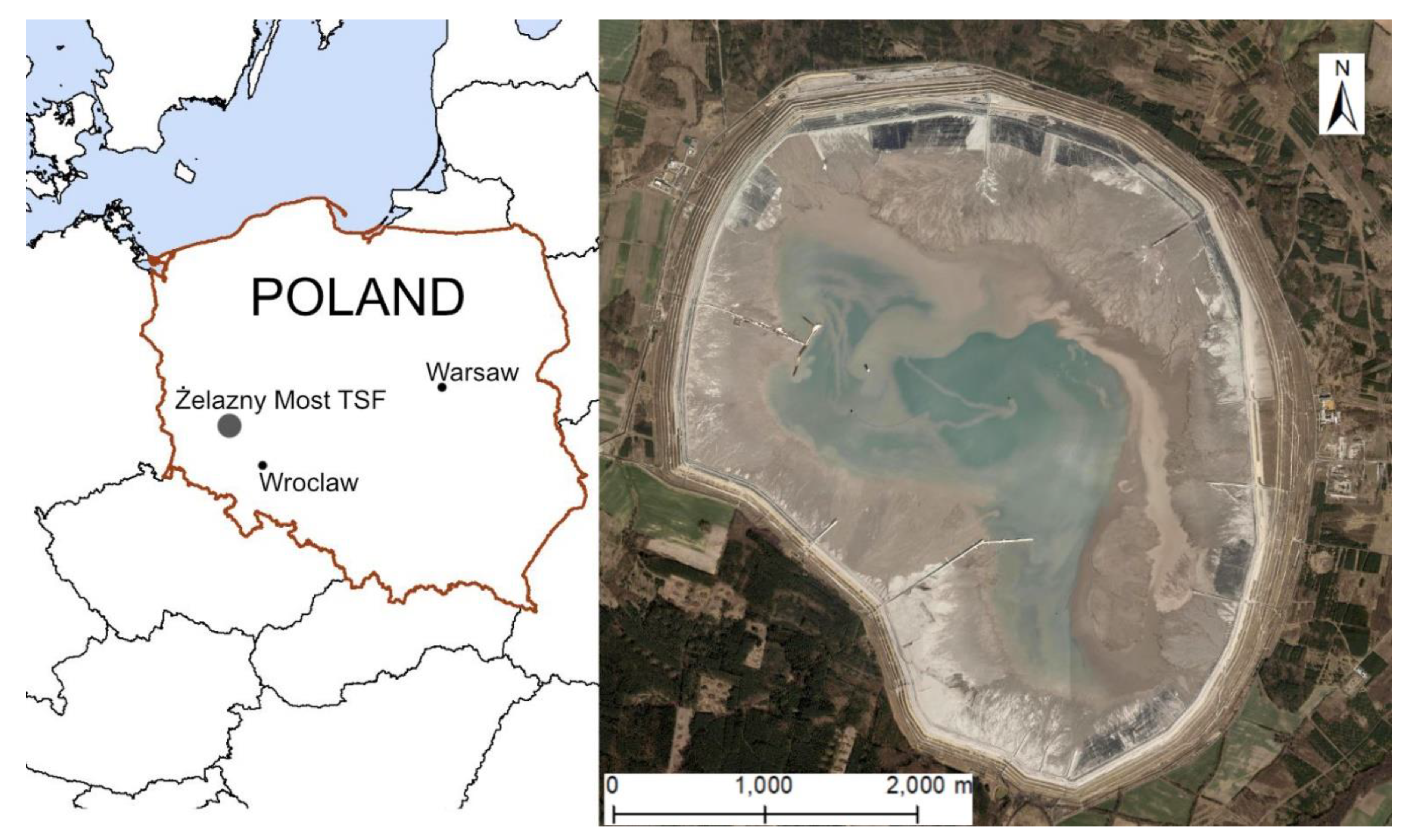
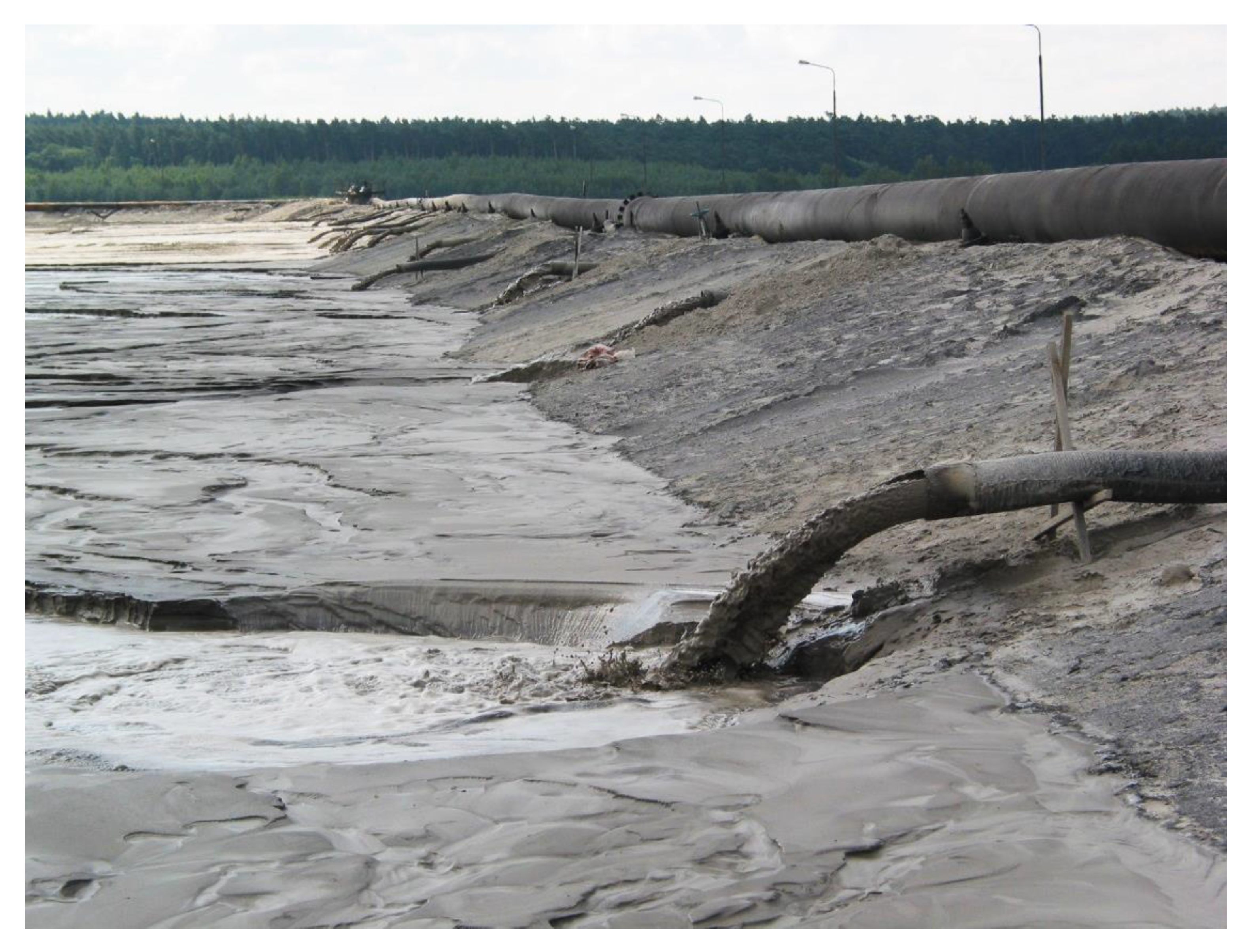

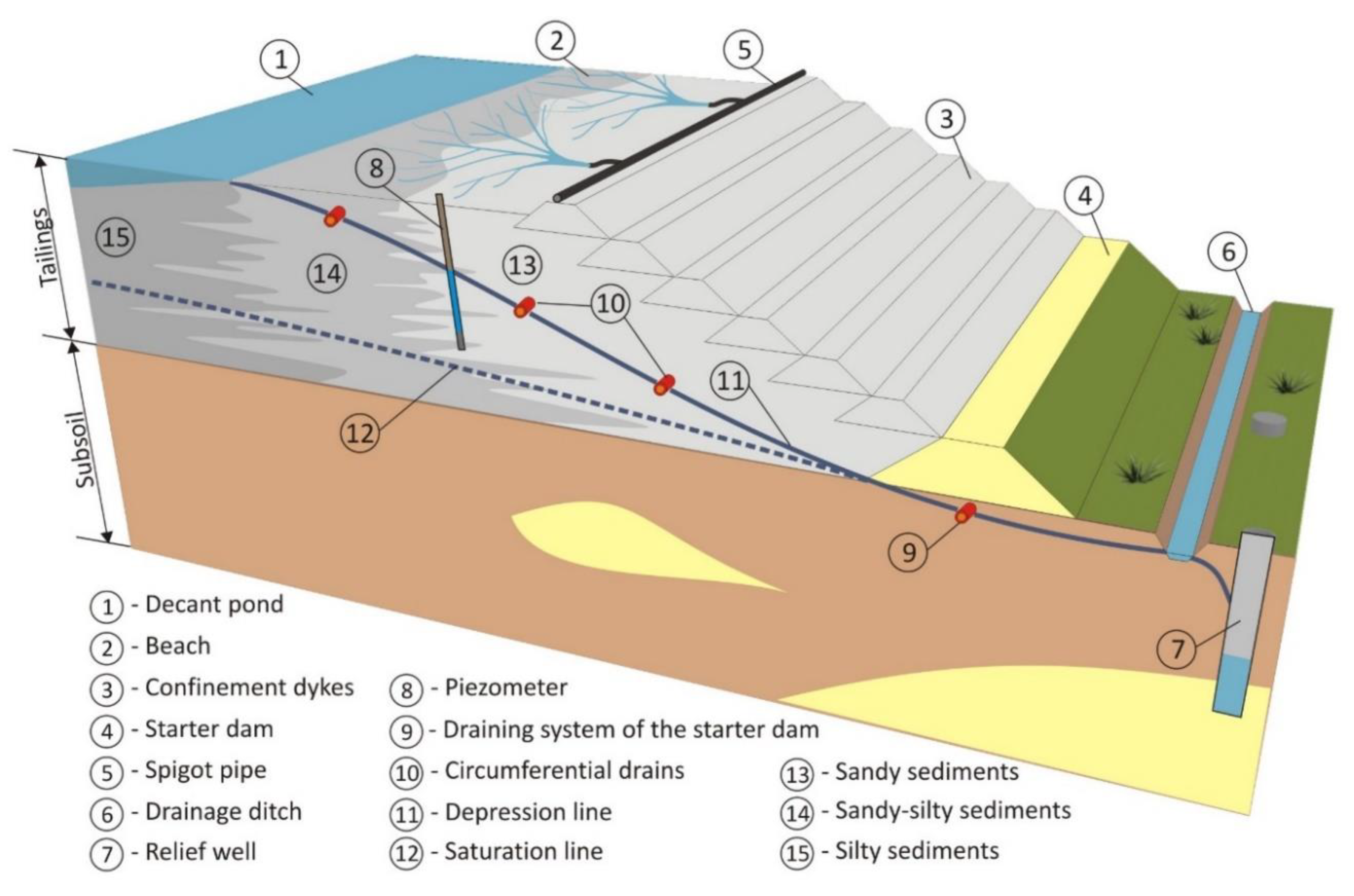
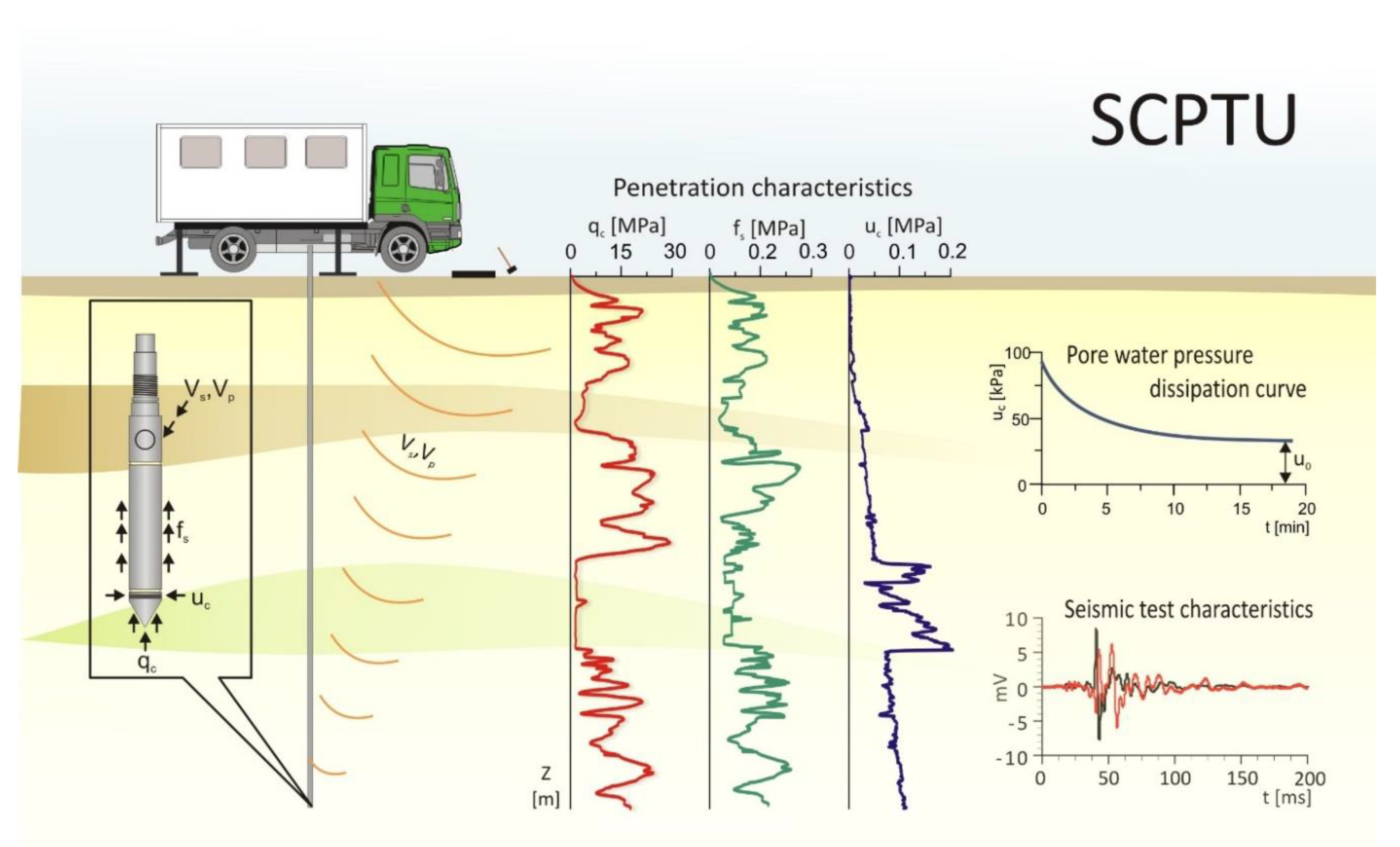
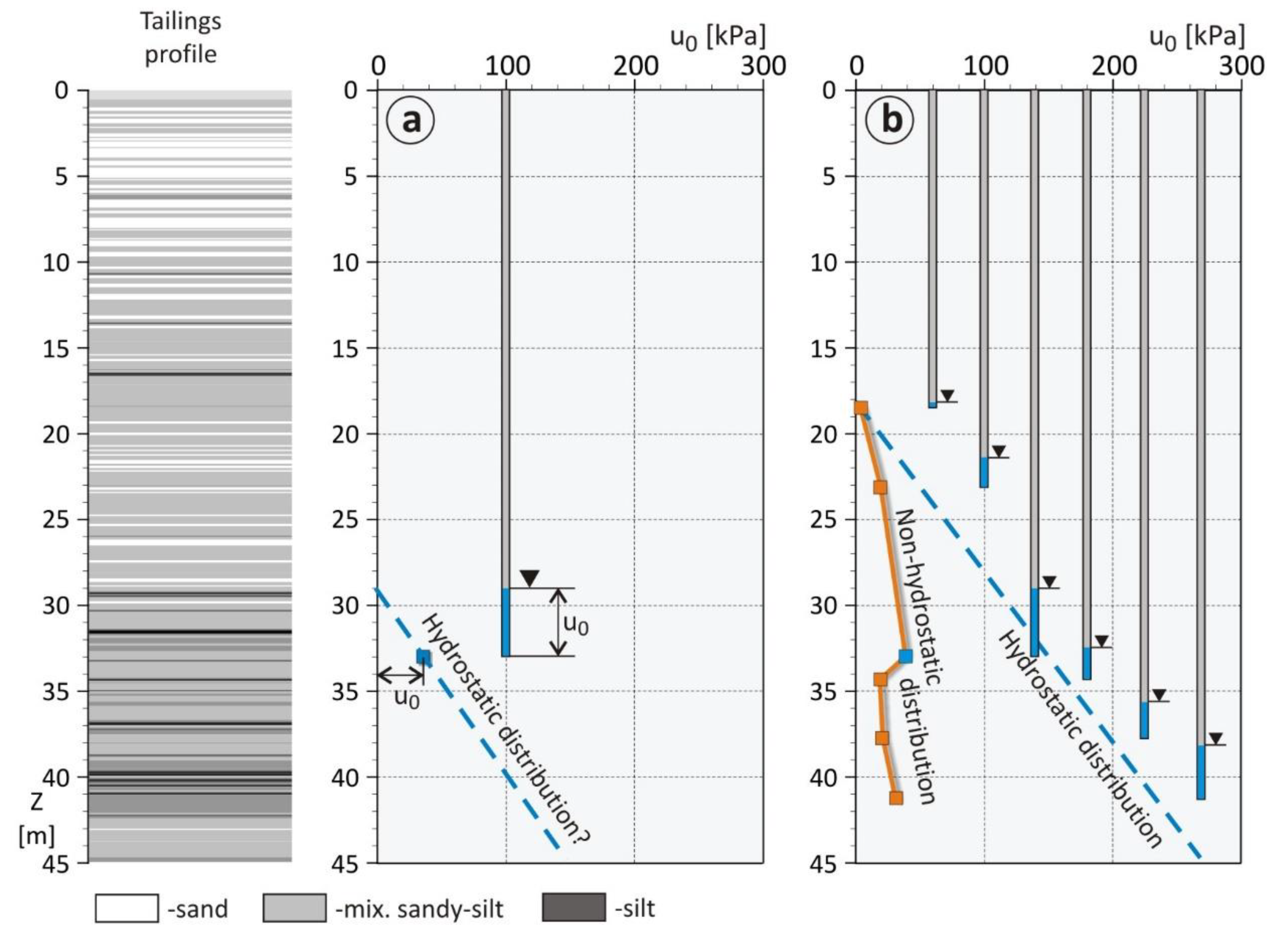
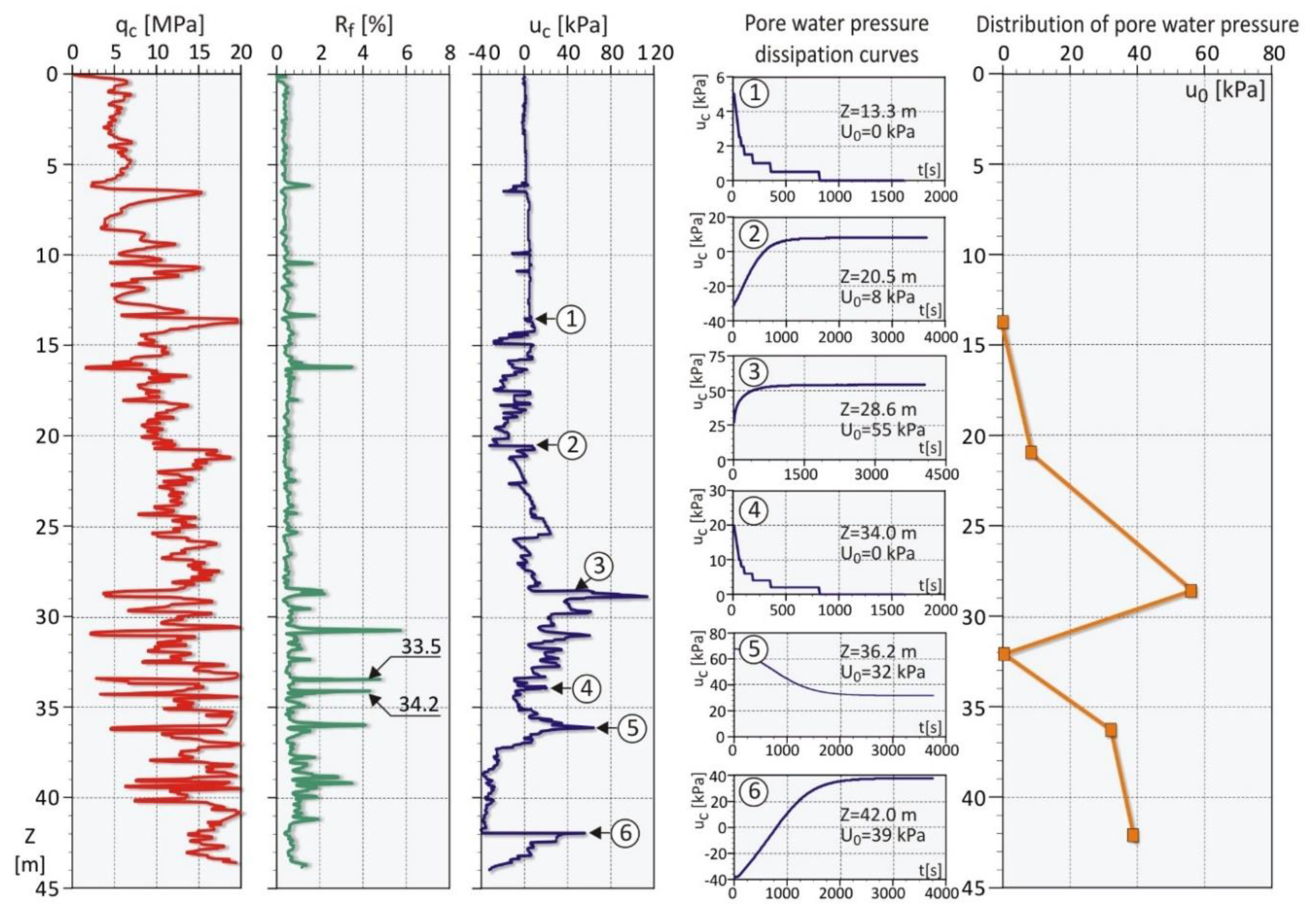


© 2020 by the authors. Licensee MDPI, Basel, Switzerland. This article is an open access article distributed under the terms and conditions of the Creative Commons Attribution (CC BY) license (http://creativecommons.org/licenses/by/4.0/).
Share and Cite
Tschuschke, W.; Gogolik, S.; Wróżyńska, M.; Kroll, M.; Stefanek, P. The Application of the Seismic Cone Penetration Test (SCPTU) in Tailings Water Conditions Monitoring. Water 2020, 12, 737. https://doi.org/10.3390/w12030737
Tschuschke W, Gogolik S, Wróżyńska M, Kroll M, Stefanek P. The Application of the Seismic Cone Penetration Test (SCPTU) in Tailings Water Conditions Monitoring. Water. 2020; 12(3):737. https://doi.org/10.3390/w12030737
Chicago/Turabian StyleTschuschke, Wojciech, Sławomir Gogolik, Magdalena Wróżyńska, Maciej Kroll, and Paweł Stefanek. 2020. "The Application of the Seismic Cone Penetration Test (SCPTU) in Tailings Water Conditions Monitoring" Water 12, no. 3: 737. https://doi.org/10.3390/w12030737
APA StyleTschuschke, W., Gogolik, S., Wróżyńska, M., Kroll, M., & Stefanek, P. (2020). The Application of the Seismic Cone Penetration Test (SCPTU) in Tailings Water Conditions Monitoring. Water, 12(3), 737. https://doi.org/10.3390/w12030737




